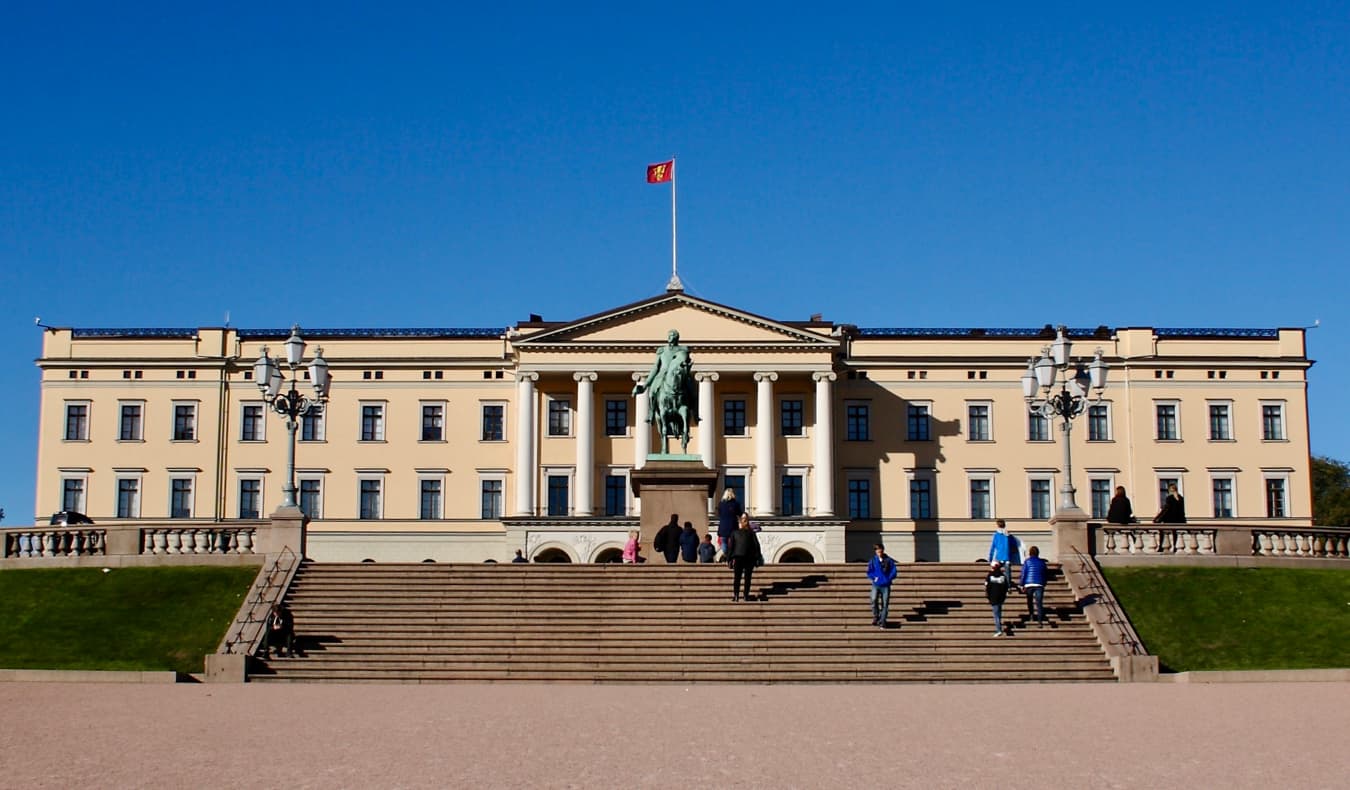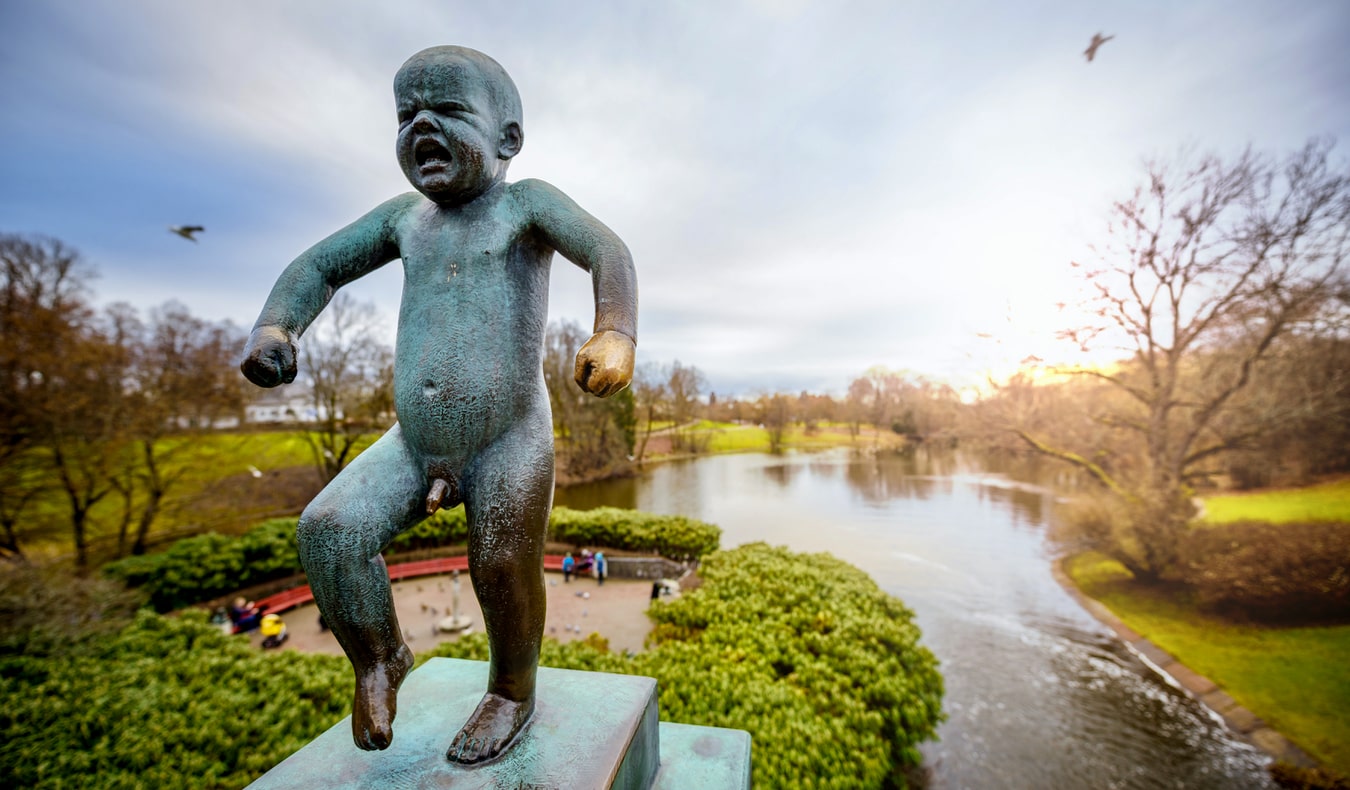
Most budget travelers skip Norway because it’s an upscale country to go to. The capital, Oslo, is consistently ranked together of the foremost expensive cities within the world due to its high taxes, strong currency, and a high percentage of imported goods.
Understandably, traveling here on a budget here is hard. Yet I still encourage you to go to , albeit it’s not a budget-friendly destination. There are unique museums, beautiful parks, and stunning nature to be enjoyed. It’s sufficiently small that a two-day or three-day visit is typically enough to urge a pity it.
To help you propose your trip and make the foremost of some time , here is my suggested 48-hour itinerary for Oslo.
Day 1

Wander Vigeland Sculpture Park
A small baby statue in Vigeland Park in Oslo, Norway
Start your day wondering this 80-acre park and see its 200 statues. Located in Frogner Park, it’s the world’s largest display of sculptures created by one artist. Gustav Vigeland (1869–1943) created the gathering of bronze, iron, and granite statues that now substitute this open-air “gallery” (you’ve probably seen the famous ‘crying baby’ statue on social media).
In the summer, the park is where you’ll find locals enjoying the long days of sunshine. There are often events and concerts held here also .
From here, head right down to Bygdøy island, where you’ll find many of Oslo’s museums.
See the Viking Museum
This museum is home to the best-preserved Viking ships within the world, a number of which go back to the 9th century. It’s a sparse museum (the focus really is on the ships) but the burial ships (as well because the preserved tools and carts from the center Ages) are incredibly rare and price seeing for yourself. The museum offers a brief film and also , though the free audio guide is that the best thanks to make the foremost out of your visit.
Huk Aveny 35, +47 22 13 52 80, khm.uio.no/besok-oss/vikingskipshuset. Open daily from 9am–6pm within the summer and 10am–4pm within the winter. Admission is 120 NOK for adults and free for teenagers under 18.
Explore the Norwegian Folk Museum
Not far from the Viking Museum is that the Norwegian Museum of Cultural History. it's a set of over 150 buildings from various periods throughout Norwegian history. It’s an open-air museum, so you'll explore both the inside and exterior of the many of the buildings, a number of which go back to the 12th century.
The most impressive of its exhibitions is Gol Stave Church, an intricately carved wooden church constructed in 1157. The museum also features a large photographic archive also as plenty of historic artifacts, documents, tools, and more.
Museumsveien 10, +47 22 12 37 00, norskfolkemuseum.no. Open daily from 11am–4pm. Admission is 160 NOK.
Visit the Fram Museum

A wooden icebreaker The Fram during a museum in Oslo, Noray
As a northern country wont to frigid temperatures and harsh winters, polar exploration may be a field intricately woven into Norwegian history. This museum highlights that history, that specialize in Norway’s contributions to polar exploration. The centerpiece of the museum is that the Fram, the world’s first ice-breaking ship. The ship was used between 1893 and 1912 and is really made from wood. The Fram made trips to both North and South Poles and sailed farther north and south than the other wooden ship in history.
The museum is incredibly detailed; there’s tons of photographs, artifacts, tools, and plenty of information. It’s a singular check out Norwegian culture through the lens of exploration.
Bygdøynesveien 39, +47 23 28 29 50, frammuseum.no. Open daily 10am–6pm. Admission is 120 NOK.
Visit the Holocaust Center
Established in 2001, this museum highlights the experiences of Norwegian Jews (as well because the persecution of other religious minorities). It’s located within the former residence of Vidkun Quisling, a Norwegian fascist who headed the Norwegian government under Nazi occupation between 1942-1945. It’s a somber and sobering place to go to but incredibly insightful with various exhibitions, photos, films, artifacts, and interviews from war II and therefore the German occupation of Norway.
Huk Aveny 56, +47 23 10 62 00, hlsenteret.no. Open weekdays 9am–4pm. Admission is 70 NOK.
Learn About the Kon-Tiki Expedition

The famous Kon-Tiki Kon Tiki in Oslo, Norway
In 1947, Norweigian historian and explorer Thor Heyerdahl used a standard Kon Tiki to cross the Pacific from South America to Polynesia. This journey began to prove that the Polynesian islands were populated from America — not Asia, as had been previously thought.
He and his small crew spent 101 days stumped . They filmed much of the experience, winning an Academy Award in 1951 for Best Documentary (he also wrote a book about the trip)
To get a way of what his journey was like, watch the 2012 historical drama Kon-Tiki (it’s an excellent travel movie).
Bygdøynesveien 36, +47 23 08 67 67, kon-tiki.no. Open daily from 9:30am–6pm (shorter hours within the autumn and winter). Admission is 120 NOK.
City Hall
End your day at hall , which is hospitable the general public and liberal to enter. While it'd not sound like a stimulating sight, tours of the hall are will offer you many insight into the town and its history. Most noteworthy are the hall’s twenty murals and works of art. They depict everything from traditional Norwegian life to the Nazi occupation. Also highlighted here is that the history of the Nobel Peace Prize. It’s awarded here annually (the other Nobel Prizes are awarded in Stockholm, Sweden).
Rådhusplassen 1, +47 23 46 12 00, oslo.kommune.no/radhuset. Open Sunday-Thursday from 9am-4pm. Admission is free.
Day 2
Wander Akershus Fortress

https://www.flickr.com/photos/claudinelamothe/30985467914/
Originally inbuilt 1290, Akershus Fortress may be a medieval fortress that evolved into a Renaissance palace under Danish King Christian IV. Currently, it’s used as an office for the prime minister. it had been built for cover and therefore the fortress has never successfully been besieged (though it did surrender to the Nazis during war II).
Inside the fort may be a military museum also as a museum dedicated to the Norwegian resistance during war II. within the summer you'll take a guided tour and there also are often events here also (mostly concerts). Check the web site to ascertain if anything is happening during your visit.
+47 23 09 39 17, forsvarsbygg.no/no/festningene/finn-din-festning/akershus-festning. Open daily within the summers 10am–4pm (winter hours vary). Admission is free.
Take a Harbor Cruise
The Oslo fjord is stunning. With its towering cliffs, calm waters, and rugged green shoreline, the Oslo fjord shouldn't be missed. you'll take a hop-on-and-off boat that shuttles people from the varied attractions and museums or enjoy a correct two-hour cruise through the fjord. i like to recommend the two-hour cruise since it goes deeper into the harbor and you see tons more. It’s a soothing thanks to spend a part of your day — especially if you’ve been on your feet all day.
Tickets for the two-hour cruise cost 339 NOK per person.
Explore the Royal Palace and Park
The Royal Palace is that the official residence of the monarch (Yup! Norway still features a king!). Completed within the 1840s, it’s surrounded by an enormous park and locals can usually be seen enjoying the long summer days here. During the summer, parts of the palace are hospitable visitors and tours. Tours last one hour and you’ll be ready to see a number of the lavish and ornately preserved rooms and study the country’s monarchs and the way they ruled Norway.
Slottsplassen 1, +47 22 04 87 00, kongehuset.no/seksjon.html. Summer hours vary. See the web site for details. Admission is 140 NOK and includes a tour.
Visit the National Gallery
While small, Oslo’s National Gallery features a wide selection of artists on display. Here you’ll find Impressionists, Dutch artists, works by Picasso and El Greco , and therefore the highlight of the gallery, “The Scream” by Munch . Painted in 1893, The Scream has actually been stolen from the gallery twice over the years. Admittedly, the gallery doesn’t have the most important collection I’ve seen but it’s nevertheless worth a visit. It’s a soothing thanks to end your trip.
The National Gallery is temporarily closed and can reopen in 2021 but you'll find a number of its collection within the National Museum.
Other Things to ascertain & Do
If you've got overtime in Oslo, here are a couple of other suggestions to assist you create the foremost of your visit:
Explore Nordmarka – The Nordmarka Wilderness Area offers everything from biking to swimming to skiing. It spans over 430 acres and is home to huts that are available for overnight stays. you'll reach the world in only half-hour by car or 1 hour by bus. Avoid happening Sunday, as that’s when all the locals go so it'll be busier (unless you would like to satisfy more locals!).
Go Tobogganing – If you visit during the winter, do the Korketrekkeren Toboggan Run. The track is over 2,000 meters long and sleds are available for rent (including helmets) for 150 NOK per day (so you'll take as many rides as you like). It’s only available when there's snow therefore the schedule will vary, however, it’s incredibly fun and fashionable the locals too!
Wander the arboretum – Home to over 1,800 different plants, this botanical garden/arboretum has two greenhouses filled with exotic plants and a “Scent Garden” designed specifically for the blind in order that they could have a sensory experience (it’s a very neat experience so don’t miss it). There are many benches so you'll sit down with a book and relax, also as works of art throughout the garden. Admission is free.
Go Swimming – Oslo is surrounded by water and has many places to swim. The water is clean and safe and locals are often found swimming all year round. Tjuvholmen City Beach, Sørenga Seawater Pool, and Huk are three spots worth finding out if you’re looking to require a dip when the weather is good .
Since there are tons of attractions involved, it’s best to urge the Oslo Pass. Like everything in Norway, attractions are expensive. If you propose on visiting many museums (and using public transportation) the pass will prevent an honest chunk of cash . The 24-hour pass is 445 NOK while a 48-hour pass is 655 NOK (they even have a 72-hour pass for 820 NOK).
While Oslo features a lot more sights and activities, two days here is manageable enough to urge a pity the town and learn its history without entirely breaking the bank (though you’ll come close!).
For Booking and Details:-
Travel Tips:-
Tours & activities:-
Accommodations:-
Check out Strikingly, the easiest website builder:-
Get your Joomla and WordPress hosting :-



0 Comments